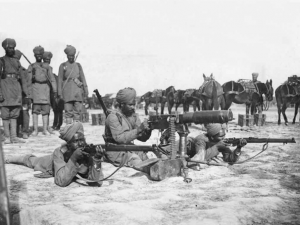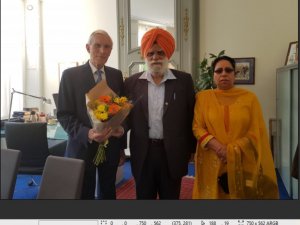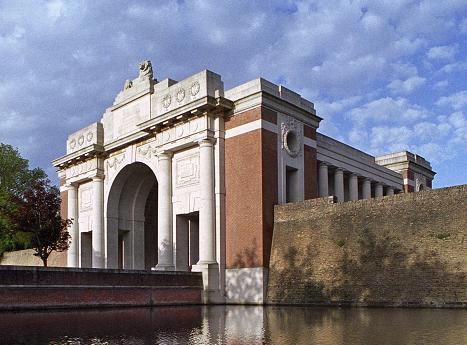 |
"He is not missing, He is here" Field Marshal Lord Plumer at the unveiling of the Menin Gate Memorial to the Missing 24th July 1927. |
Ypres (now Ieper) is a town in the Province of West Flanders. The Memorial is situated at the eastern side of the town on the road to Menin (Menen) and Courtrai (Kortrijk).
Each night at 8 pm the traffic is stopped at the Menin Gate while members of the local Fire Brigade sound the Last Post in the roadway under the Memorial's arches. This paying of homage has started from 1927.
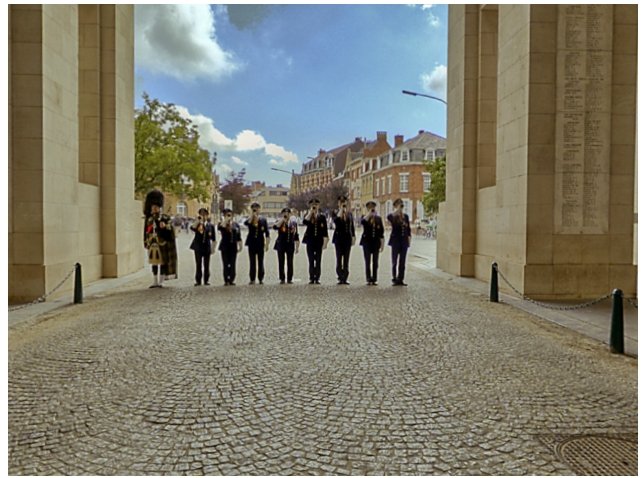 |
 |
The Menin Gate is one of four memorials to the missing in Belgian Flanders which cover the area known as the Ypres Salient. Broadly speaking, the Salient stretched from Langemarck in the north to the northern edge in Ploegsteert Wood in the south, but it varied in area and shape throughout the war.
The Salient was formed during the First Battle of Ypres in October and November 1914, when a small British Expeditionary Force succeeded in securing the town before the onset of winter, pushing the German forces back to the Passchendaele Ridge. The Second Battle of Ypres began in April 1915 when the Germans released poison gas into the Allied lines north of Ypres. This was the first time gas had been used by either side and the violence of the attack forced an Allied withdrawal and a shortening of the line of defence.
There was little more significant activity on this front until 1917, when in the Third Battle of Ypres an offensive was mounted by Commonwealth forces to divert German attention from a weakened French front further south. The initial attempt in June to dislodge the Germans from the Messines Ridge was a complete success, but the main assault north-eastward, which began at the end of July, quickly became a dogged struggle against determined opposition and the rapidly deteriorating weather. The campaign finally came to a close in November with the capture of Passchendaele.
The German offensive of March 1918 met with some initial success, but was eventually checked and repulsed in a combined effort by the Allies in September.
The battles of the Ypres Salient claimed many lives on both sides and it quickly became clear that the commemoration of members of the Commonwealth forces with no known grave would have to be divided between several different sites.
The site of the Menin Gate was chosen because of the hundreds of thousands of men who passed through it on their way to the battlefields. It commemorates casualties from the forces of Australia, Canada, India, South Africa and United Kingdom who died in the Salient. In the case of United Kingdom casualties, only those prior 16 August 1917 (with some exceptions). United Kingdom and New Zealand servicemen who died after that date are named on the memorial at Tyne Cot, a site which marks the furthest point reached by Commonwealth forces in Belgium until nearly the end of the war. New Zealand casualties that died prior to 16 August 1917 are commemorated on memorials at Buttes New British Cemetery and Messines Ridge British Cemetery.
The YPRES (MENIN GATE) MEMORIAL now bears the names of more than 54,000 officers and men whose graves are not known. The memorial, designed by Sir Reginald Blomfield with sculpture by Sir William Reid-Dick, was unveiled by Lord Plumer on 24 July 1927.
Sikhs under the Lahore division have fought here twice ie from 22 october 1914 to 31st october 1914 in the first battle of Ieper and from 22 april 1915 to 1st may 1915 in the second battle of Ieper.
On 22nd October 1914, the Ferozepore Brigade arrives in the "new-born" Ypres Salient. They are sent to the trenches between Hollebeke in the north and Messines in the south. The trenches were not an uninterrupted line then, but was more a series of loose trenches, without the complex system with saps, communication trenches etc. that we are to know later in the War.
The 1st Connaught Rangers - the British battalion that belonged to the Ferozepore Brigade - were the first to have their baptism of fire. The first Indian battalion that had to go into the firing line was the 57th Wilde's Rifles in the vicinity of Wijtschate - Oosttaverne.57th Wilde's Rifles (Dera Ismail Khan) consisted of: 2 Sikhs, 2 Dogras, 2 Punjabi Moslims, 2 Pathans.
I will mention here the last two days of the first battle of Ieper. For full detail, please read http://sikhspectrum.com/2003/01/battles-of-ieper-belgium-1914-1915/
On 30th October, after a heavy initial bombardment, the Germans attacked the Indian troops from the ridge of the Zandvoorde. The Indian and British troops were by far in the minority, had little ammunition and sparse artillery support, so it was obvious that it would be very hard to stand to. Two companies of the 57th Wilde's Rifles withdrew to Messines, where they were dispersed in the streets of the town. There was one officer there to point out the direction of HQ in Wijtschate, but some got lost and arrived in Kemmel, some 2.5 miles wrong! Other units of the 57th Wilde's Rifles were also forced to withdraw. Thus, a Sikh company had to take a new position in the neighbourhood of a battery near the mill east of the Wijtschate-Messines Road.
Another company did not get the order to withdraw as all means of communication were cut or lost. When the message finally came through, it was too late as they were completely surrounded by German troops. The Baluchis too, in the neighbourhood of the chateau on the other side of the canal and the railway, had very difficult times when standing.
|
The Daily Act Of Homage The Last Post, the traditional final salute to the fallen, is played by the buglers in honour of the memory of the soldiers of the former British Empire and its allies, who died in the Ypres Salient during the First World War. It is the intention of the Last Post Association to maintain this daily act of homage in perpetuity. |
The battle raged on until the next day. After a bombardment that lasted the whole night, Messines was stormed by nine German battalions. They overwhelmed the trenches of the 57th Wilde's Rifles and many units of this battalion were literally annihilated. Jemadar Ram Singh was the only survivor of his platoon.
Another Sikh, jemadar Kapur Singh, kept on fighting until everyone else was out of action, except for one wounded sepoy. As he did not want to surrender, he committed suicide with his last bullet. All British officers of the 57th Wilde's Rifles, present on this part of the front, were killed. On that same day 31st October 1914 in the vicinity of Hollebeke, the action took place for which, some months later, Khudadad Khan of the 129th Baluchis was going to be the first Indian to be awarded the Victoria Cross.
On 22nd 1915 at 5pmSecond battle of Ieper began with the first successful gas attack in history.
The attack started on 22 April 1915 at Steenstrate-Schreiboom in the north of Ieper, Belgium. Canadian and British soldiers - including Sikhs - were the earliest victims.
The 2nd attack was on 24 April 1915 at St. Juliaan's Graventafel in the north of Ieper in which again, the Canadian, British and Sikh soldiers were the victims. A huge Canadian memorial is situated at Langemark to mark the event.
The 3rd and 4th attacks took place on 26-27 April 1915 at Steenstrate-Lizerne, near Ieper, in which British, Sikhs and French were the victims. To the left of the Sikhs were French Colonial troops with essentially North Africans and at their right were the British. The Ferozepur Brigade, and the French colonial troops to the left of them, were the worst hit.
More gas attacks followed on 27-29 April and 01-02 May 1915 and the victims were again British, Sikhs, Pathans, French and Algerians. Canadian artillery were backed by the Sikh troops.
Gas attacks are also recorded on 02, 05, 06, 10, 24 May 1915 near Ieper, by the Germans.
From 22 April 1915 till May 01, counter attacks were done by the British, Canadian, French, Belgium, Australian, New Zealanders, Sikhs, Algerians, Morocco and troops of many other nationalities.
Between 24 April and 1 May, the Lahore Division had lost 3889 men - about 30 % of the deployed soldiers - mostly Sikhs in and around Ieper.
HISTORICAL BACKGROUND
On 22 April 1915 at 5 pm, the 2nd Battle of Ypres began with the first successful gas attack in history. The British Indian Corps - not yet recovered from the terrible Battle of Neuve-Chapelle - was called upon to fill a gap in the line.
The Lahore Division was now under command of the British 2nd Army of Smith-Doreen. Among the British Indian troops, the warning was spread that, in case of the use of gas, a handkerchief (or the pagri-dastaar) was to be placed over the mouth. It was recommended to soak the handkerchief (or pagri) in urine.
After the gas attack, the Germans had gained a considerable portion of the northern part of the Ypres Salient. Now the British, together with the French troops, wanted to make a counter-attack in order to force the Germans to withdraw from this new position.
On the morning of 26 April 1915, the Lahore Division assembled between the Ieper-Langemark road on the left and Wieltje on the right, some 600 yards north of la Brique. The Ferozepore Brigade moved to its position through Vlamertinge, but the Jullundur Brigade went to Wieltje by the road winding along the Ypres ramparts. There they were caught in a heavy bombardment.
As soon as the division was deployed in the fields near Wieltje, they were shelled with tear gas. After the first gentle slope, they arrived in an inferno of gunfire, machine gun fire and shells, among which also tear gas shells. The men fell by the dozen.
It is obvious that the number of casualties was extremely elevated. The 47th Sikhs, which was in the first line of attack, lost 348 men from a total of 444, or 78% of the battalion! It was almost annihilated.
In total, the attack resulted in almost 2000 casualties in the two brigades. During this attack, Corporal Issy Smith of the 1st Manchester's, which belonged to the Jullundur Brigade, won a Victoria Cross. Amidst heavy shelling and continuous gunfire, he had ceaselessly evacuated the wounded.
Also Mule Singh and Ruhr Singh of the 47th Sikhs distinguished themselves by saving many lives. Bhan Singh, a Sikh of the 57th Wilde's Rifles, was wounded in the face early during the attack. Nevertheless, he stayed near his officer, Captain Banks.
When Banks fell, Bhan Singh thought of just one thing - bringing Banks back, dead or alive. Weakened as he was, he stumbled on with Banks' body under heavy fire until he was completely exhausted. However, he did not return without first saving Banks' personal belongings.
Germans reopened the gas cannisters at 2.30 pm. When the gas reached the Sikh troops, a Sikh havildar was heard shouting: "Khabardaar, Jehannum pahunche", which means "watch out, we have arrived in Hell". In no time the ground was filled with men being tortured in a terrible way.
But let's get back to the night of 26-27 April 1915 when the chlorine gas was to be ingested through the whole night. Only late that night could the remnants of Major Deacon's party be relieved. The Ferozepore and Jullundur Brigades were withdrawn to the Brieke while the Sirhind Brigade replaced them in the first line.
Men of the 34th Sikh Pioneers tried to consolidate the difficult position when Major Deacon tried to keep a stand.
Later, two men of that unit, sappers Jai Singh and Gujar Singh, were awarded the Indian Distinguished Service Medal because they had established communication lines under constant fire.
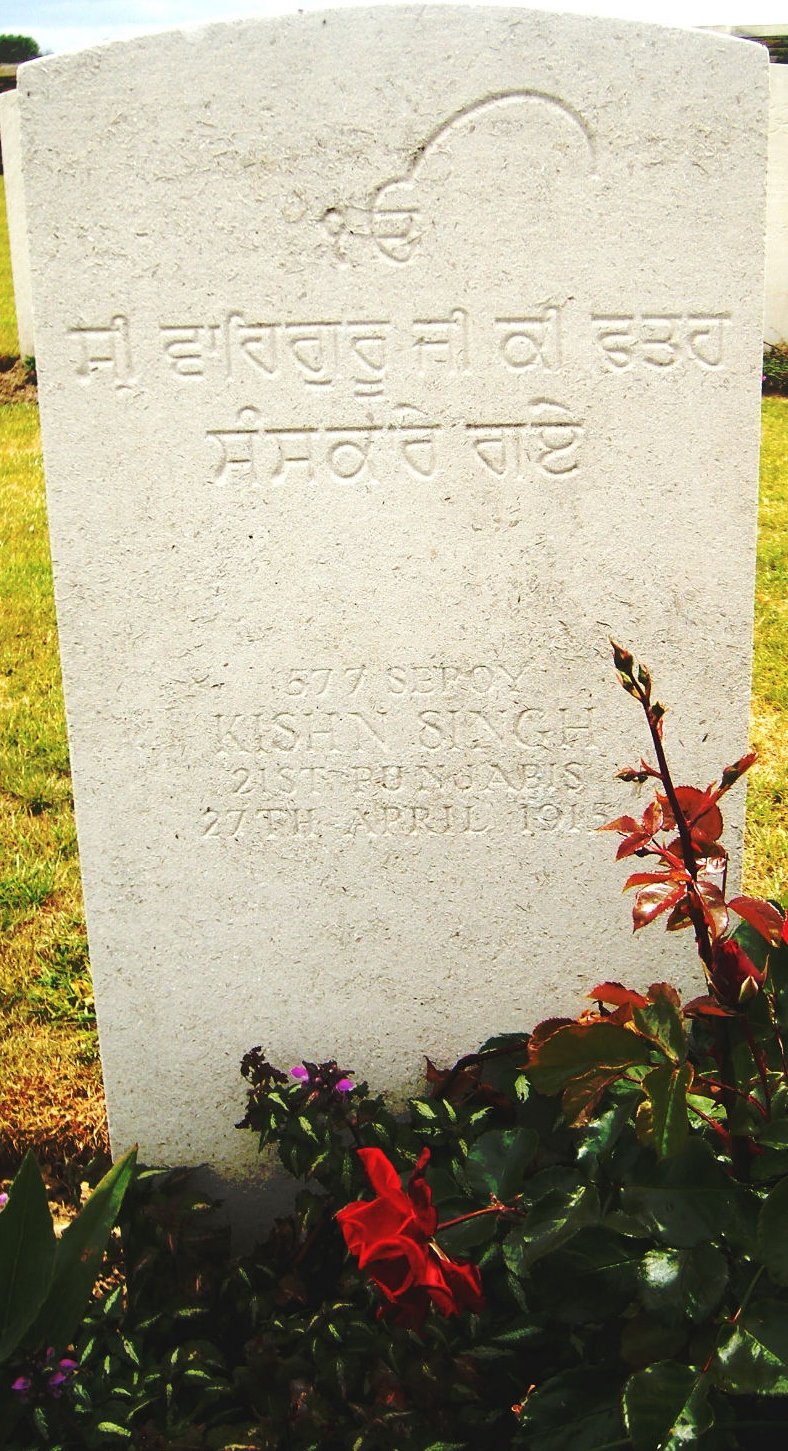 By the end of 1915, more than half of the Indian army Corps had left Europe. There were always some Indian battalions at the Western Front, for example, during the battle of the Somme.
By the end of 1915, more than half of the Indian army Corps had left Europe. There were always some Indian battalions at the Western Front, for example, during the battle of the Somme.
"In 14 months the Indian Corps had lost 34,252 men (dead, wounded, ill, or prisoners of war) on the Western Front. Sikhs were 40 % in the British Indian Army. They were all baptised Sikhs ( Amritdhari ) and fought with wearing their Turbans. According to one report, 8 thousands Sikhs died in France and 4 thousands in Belgium.
According to Commonwealth War Grave Commission Register France = 8318 + Belgium = 493 Thus Total = 8811 have died on Western Front which is far behind the truth. But I am sure there are many more Indian casualties whose names were never recorded and who are by consequence not commemorated. I think this is due to the battle circumstances and perhaps poor administration or India being the colony of England. According to my research I give you some examples:
The losses of the 57th Wilde's Rifles and the 129th Baluchis were great during the last two days of October 1914 (during the 1st battle of Ieper). The Wilde's Rifles lost 300 out of 750, the Baluchis had 240 men killed, wounded or taken as POWs.
The Menin Gate in Ieper has the name of 15 casualties from the 47 Sikh Regiment while alone on 27 April 1915 (during the 2nd Battle of Ieper) out of 444 men 348 did not come back. They are nowhere else commemorated.
Between 24th April and 1st May 1915, the Lahore Division had lost 3,889 men, or 30 % of the troops it had employed."
After the bloody battle of Neuve Chapelle, France (10 till 13March 1915) the Sikh Regiments had lost eighty percent of their men and three regiments stood at only sixteen percent of its original composition.
On Menen Gate are engraved only 122 names of the Sikh soldiers who died in and around Ieper. Sikhs throughout Europe are paying respect to Sikh soldiers of Menen Gate since 1998 every year on November 11 though it was started in 1927 by the people of Ieper.Official invitations are mailed to all the Gurdwara's of the Netherlands, Belgium, France and many other Sikh Organizations in Europe and abroad by the Mayor of Ieper. Sikh serves Langar and Tea also. A monument in the memory of Sikh soldiers was built by Ieper authority and foundation was laid down by Panj Piaras ( 5 beloved Sikhs) on the occasion of 300 years of the revelation of the Khalsa on april 1999 at Hollebeke , a town 8 km from Ieper, where Sikhs were deployed in 1914.
City of Ieper in collaboration with the European Sikh Community have the honor of organizing 'A celebration of Peace' to commemorate 300 years of the Khalsa, in remembrance of the Sikh soldiers of World War 1 on Friday 2 april, Saturday 3 april, Sunday 4 april in Cloth Hall ( Town Hall ), Ieper, Belgium. Akhand Path of Siri Guru Granth was performed in the town Hall of Ieper besides an Exhibition on Sikh soldiers and History was on display. Living Sikh soldiers from United Kingdom were brought to Ieper and were honored by Governor Paul Brijne of West Flanders province besides the family of Hawaldar Badan Singh who fought in Ieper, his daughter Harbhajan Kaur Sandhu and her children Sapinder Singh, Jaspal Singh, Surinder Kaur and her husband Swarn Singh, all living in Gent-Belgium were honored. Dr. Winand M Callewaert, head of department of Asian Studies, Catholic University, Leuven gave daily lecture on role of Sikh Soldiers, Sikh Religion and History for a week in the Town Hall of Ieper. Three Mayors from UK Sardar Inder Singh Jamu, Sardar Tarsem Singh Bhogal, Janab Abdul Karim Sheikh participated with many prominent diplomats and famous Bhangra Team, Ruh Punjab Di, from Birmingham, performed the folk Punjabi dance Bhangra. Since then, A Celebration of Peace has become a very important part of Sikh Soldiers, Sikh Religion and their History in the European Continent.
Arrival of Sikh Soldiers in Marseilles-France at the end of September 1914 and fighting the Nazi Germany on 22 October 1914 at Wijtschate-Oosttaverne in Belgium for the first time are great historical events in the European Continent History and thus in 2014, Sikh Nation should celebrate the 100 years of the arrival of the Sikhs in Europe on a large scale according to Sikh Tradition.
Sikh Nation have now 3 monuments. Hollebeke, April 1999, Wijtschate, November 9, 2008 (both in Belgium WW1) and Forly in Italy, August 13, 2011 (WW2).
Almere, The Netherlands
16-06-2012





